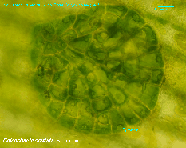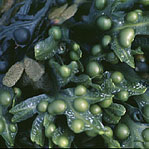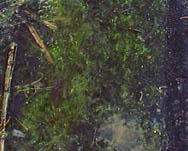




Algae
Algae are phototrophic microorganisms, meaning that they depend on light to thrive, and generally they live in water. They can be unicellular or multicellular and by the Whittaker Classification scheme they fall into two kingdoms - Protist and Bacteria.
The commonest group is known as Green Algae (Chlorophyta) and this is the most diverse, with more than 7000 species identified. It is generally found in water and as with green plants, its color is due to the presence of chlorophyll a and b. This is in two forms and is used to manufacture sugars from the sunlight that the algae is exposed to. The sugars are the main energy source for the algae which uses them to grow and reproduce. They can exist as single cells, filaments, colonies and in multicellular form. Algae filaments or strands are readily visible to the naked eye if present in sufficient quantity. Typically, they form green floating mats in ponds and ditches, where the water is generally still or slow moving. However the habitat of other green algae includes sea water as well as faster flowing fresh water. Marine algae is often found attached to rocks, and is exposed during low tides. Some of these varieties, such as Sea Lettuce, are readily visible and are hardly microorganisms, though genetically they are certainly protists.
 |
 |
 |
|
(Left) Coleochaete scutata
Protist
and algae gallery © 1999 Charles
J O'Kelly and Tim Littlejohn, University of Montreal
|
(Center) Bladderwrack
seaweed Fucus vesiculosus
Seaweed
Gallery © Michael D Guiry
|
(Right )Spirogyra |
Green Algae have a wide variety of life cycles, though they reproduce sexually. In most instances their gametes and spores have two flagella - tail-like structures that are used to propel the spore through the water. Flagella are found in many species of micro-organism, including bacteria.
Spirogyra is probably the best known of the Green Algae, it is found in streams and ponds right across the world. School ponds and biology laboratories often cultivate it for experimental study purposes. Unlike most green algae, however, Spirogyra spores do not have flagella, for they reproduce by conjunction.
Red Algae (Rhodphyta) and Brown Algae (Phaeophyta) also exist. They are multicellular and the cells can be quite different from one another, serving different functions. As with the green algae these are protists and they can be quite large. Bladderwrack and kelp seaweed, for instance, are a brown algae. Bladderwrack typically grows to about the size of a potted houseplant and is loved by children when visiting the beach; they enjoy popping the berry-sized bladders. Nearly all red and brown algae live in the sea, and their preferred habitat is along the seashore. In deeper water they would not receive enough sunlight. They both contain chlorophyll a and carry out photosynthesis. Brown algae also contain chorophyll c and their color comes from a pigment called fucxanthin. Red algae contain a different pigment called phycoerythrin, which causes their reddish appearance. Agar, the jelly that is used as a culture medium for microorganisms in the laboratory, is extracted from red algae. Certain types of red algae (eg kelp) are eaten in some societies, without being processed, while various extracts from brown algae are used in the manufacture of ice cream. Iodine, which has a number of uses in the chemical and medical industries, can be extracted from some brown algae.
Bacterial green algae also exist and this includes certain members of the chromista, rhodophyta, and photosynthetic groups of bacteria. Another bacterial group is classed as blue-green algae, but this belongs to the cyanobacteria because it lacks a nucleus in the cell, and cannot be classed as algae in the strict sense.
Go
to
Home
| Space Station
| Mars | Rainforest
© 1999 Satellite Events Enterprises Inc.